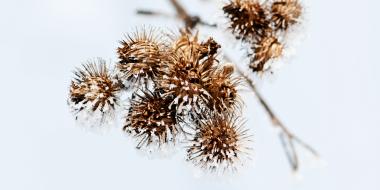Ever wonder about how you can help bees survive and thrive? Eighty percent of flowering plants depend on pollinators to help them transfer pollen, and one third of every mouthful of food we eat or beverage we consume is made possible by pollinators. That’s pretty important stuff! Yet we don’t pay much attention to these hard-working little guys until something goes wrong with our honey supply; colony collapse disorder has devastated honeybee populations in the last few years. You can do bees a solid by creating simple habitats to keep them buzzing busily in your own yard!
All about the bees and the bees
While the honeybee is responsible for a fair bit of pollination, there are many other important native pollinators that come in a variety of shapes and sizes (honeybees are not native to North America). There are 800 bee species in Canada, including bumble bees, many different kinds of wasps, flies, butterflies, moths, ants and even birds and mammals are responsible for some pollination. The most common native pollinators are actually solitary bees – this means they do not live in hives or colonies like honey or bumble bees. The mason bee is a solitary bee responsible for pollinating valuable crops such as apples, alfalfa, watermelon, sunflowers, strawberries and blueberries. Bumblebees are among the hardest working pollinators, going from dawn until dusk no matter the weather. Honeybees don’t like cloudy or rainy days and like to warm up before getting going in the morning. There are 41 different species of bumblebee in Canada alone.

Bumblebee life cycle
Bumblebees are social bees. They live in a colony, share the workload to care for the Queen and her young, and have multiple overlapping generations throughout spring, summer and fall. They are generalist feeders, foraging on a wide range of plants. They will not reuse the same nest twice.
Mason bee life cycle
Mason bees live on their own rather than in colonies and unlike the bumblebee Queen, who does all the egg laying, each female mason bee will lay her own eggs. Females start looking for suitable nest sites in March. They like to be warm and dry and sometimes nest under wood shingles on the south side of a building or in old insect holes in a tree. Once she finds a good hole, she places a mud plug at the bottom of it and brings in 15 to 20 loads of nectar and pollen. She then lays an egg and seals the cell off with another thin mud plug. She keeps building outwards from the back of the hole in this way until it is almost full. She then plugs it with a thick wad of mud. She makes one to two eggs a day and lives for about a month. The larvae hatch within only a few days. Once they have eaten all the food their mother left for them, they spin a cocoon and pupate within the cell. Near the end of summer they transform into adults but stay within the cocoon until spring. The males are laid closer to the entrance of the hole so they start to chew their way out first in spring. The females emerge several days later.
Bee Safe!
Before you begin your project, observe a few simple rules to avoid getting stung.
- Avoid leaving sweets and other foods exposed
- Avoid perfumes when in heavy bee area
- Avoid sudden movements
- Avoid walking barefoot (many bees and wasps nest in the ground)
- Avoid bright coloured or patterned clothes (unless you want to be confused with a flower!)
Get busy building!
Attracting lots of pollinators to your garden will not only ensure good vegetable and fruit crops, it can be quite fascinating for your kids. Like watching the flames of a fire dance, there is something mesmerizing about watching a bee flit from flower to flower. Native bee populations have not been as affected by colony collapse disorder as honeybees, but they could still use your help finding healthy sources of food and suitable habitat.
A fun project to do with the kids is to make homes for bumblebees and mason bees. If you are lucky, a queen bumblebee or mason bee will take up residence in the spring and start laying their eggs.
How to make a bumblebee home

Materials
- Flower pot – minimum 10 cm diameter
- Chicken wire – 1 sq ft
- Bedding material – upholstery stuffing or quilter’s batting works well but must be natural material. Little bee legs get caught up in synthetic fabrics. Finely chopped dried moss or grass clippings can also be used
- Stones – a few small pebbles and a slightly larger stone for weight
- Window screening – few small pieces
- Flat piece of waterproof material such as wood, plastic or slate to cover entrance hole
- Duct tape (can any project be done without it?)
Instructions
1. Your flower pot
- If the pot has a hole on the bottom, ensure it is between 1.5 to 2.5 cm in diameter. If there is more than one hole, cover the others with screen to prevent ants from raiding the nest. The screening allows for ventilation.
- If your pot has side drainage holes (as in the photograph) ignore tasks 5 and 6. Instead, cover all of the holes except one with screen. This can be secured with duct tape.
2. Wad up the nesting material and make a little depression in the centre for the Queen. Stuff this into the pot with the depression facing the bottom of the pot. (The bumble bee usually claims an old mouse or vole burrow for it’s home so the very best bedding is actually the entire contents of an old mouse nest complete with droppings, however this is not always possible to find.)
3. Scrunch up the chicken wire so that it will fit into the pot and keep the nest material from coming in contact with the soil so that it stays dry.
4. Turn your pot upside down and find a suitable location for it – a secluded area of the garden amongst some tall grass or flowers where it will not be disturbed is best. Bumblebee hives do not need to be exposed to the sun. The nest can be at ground level, half buried, or buried completely leaving an inch exposed at the top so the entrance hole does not get flooded.
5. Place 3 or 4 pebbles around the entrance hole and lay the flat wood or slate across them. Weight this down with a heavier rock.
If you are lucky, a Queen bee will choose your nest to start a new colony in the spring after she awakes from hibernating in piles of dry leaves and grass.
How to make a mason bee condo

Materials
- Dry log, around 7” long and at least 3” diameter
- Drill
- 5/16” drill bit, preferably 6” long (wider and narrower bits can be used for different species of solitary bees)
- 2 litre pop bottle or other waterproof material for roof
- Staple gun, small nails or heavy duty glue
Instructions
1. Drill a series of holes in the end of the log for females to lay eggs in. She will produce the greatest ratio of female to male eggs if the holes are 6” deep (females do most of the pollinating work so you want more of them).
2. Holes of different sizes can be drilled to attract different species of pollinators (I like to do this to ensure variety in my garden and make it more likely that something will come nest in my home if there don’t happen to be any mason bees passing by).
3. Create an overhanging roof by cutting off a wide section of the pop bottle and wrapping it around the top half of the log. Feel free to improvise with other recycled materials. We reused leftover wooden shingles that we had in the shed. Affix this with a staple gun.
4. Mount your bee condo in a southeast facing location (to get them all warmed up in the morning and out working earlier) at least a couple of feet off the ground so that critters don’t get in. This can be done with string, by nailing into a piece of wood you can easily mount on a wall, or by affixing to a free-standing post.
Maintain a safe distance and watch as your bees discover their new home!






